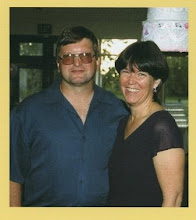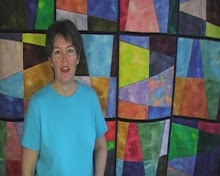I don't have the room or the money for a huge expensive sewing cabinet, and being the innovative person that I am, I created my own design for a sewing table and because I work hard at my craft, I call it my Quilting Desk.
I started with 2 relatively inexpensive folding tables from SAM'S Club ($42 each in Anchorage, Alaska) that measure 2' wide x 4' long, some rigid foam insulation and clear vinyl - 54" wide and on a roll, in the fabric section of WalMart (JoAnn's probably has it too) $2-3 per yard. I use 2 tables because I quilt large quilts and I cannot have any drag on the fabrics as I am quilting them - I need a perfectly flat surface for several feet, all around the sewing machine.
After setting the height of the tables to just clear the tops of my thighs as I sit in my most comfortable chair at the table, I put my sewing machine on the table top and measured the height from the top of the table to the top of the stitch plate. It measured at 3½" and I purchased 2 pieces of rigid foam insulation - 1 piece of 2" thick x 8' long x 2' wide and 1 piece 0f 1½" thick x 8' long x 2' wide.
I cut the length of each piece in half, to make 4' sections, and then lay each 2" x 4' onto each table, then put the 1½" x 4' sections on top. Then I made the cut out for the sewing machine to fit in. I set the sewing machine on top of the foam insulation and positioned it as far away from me as I could comfortably sew and quilt. I like a lot of support space in front of the needle, to support a heavy quilt as I am quilting it.
I used a pen to mark a space around the sewing machine and set the machine aside. Using a serrated knife to cut the foam, I cut out the space for the sewing machine from both layers of foam. I started with a cut to just fit the sewing machine, but then went back and made it bigger because I wanted space to access the front loading bobbin area easily. I then made 1 straight cut through the top layer of foam only, to create even easier access to the bobbin. When I need to change bobbins, I just slid this piece out a few inches, giving my hand access to the bobbin area.
Lastly, I lay the clear vinyl over the top of the foam and around the sewing machine. This vinyl is so slick that everything including heavy quilts just glides right over it - sweeter than sweet! I put it in place and then cut out an area just larger than the feed dogs, and taped all 4 sides of the cut opening to the sewing machine. Because I have bad eyes and am a poor ¼" seamstress, I put a strip of black electrical tape (you can use masking tape or anything else you want) to mark the ¼" edge for quilting.
For inspiration and for fun, I slide photos, magazine pages and quilt patterns under the clear vinyl so that I don't always have to look at the blue foam. In the photo you can see that I also use the table top for my pressing surface (try not to notice how dirty my pressing pad is!).
In about an hour I had a custom Quilting Desk that is completely portable and stores easily. The tables have folding legs and they can fit in a closet and so can the blue foam insulation. Updated photos here....
This video shows the basics ...
This video shows how I convert the set up to support big quilts for machine quilting .....
Here are a few more notes and a mistake I made:
Sweetpea Pods Sew Along
-
Join us for our upcoming sew along! We’re making Sweetpea Pods starting on
Tuesday, August 22. You can join in at anytime! When you sign up for the
sew alo...
2 years ago









15 comments:
Hi, Welcome to Quilters Home newsgroup. I followed the link to your blog, and have enjoyed reading it. This desk idea is genius. I can't afford to buy a sewing cabinet, and don't have the space for it either, but this sounds like a wonderful way to get the features of one.
What a clever girl you are M. Why, I'll bet your machine even sounds quieter with all that insulation around it!
The vinyl doesn't slide at all?
I'm adding you to my list. Welcome to Blog-land, maybe we can meet some time when you come to Anchorage, or when I head down to Seward. We'll be down there for fishing this summer. Our feezer is officailly out of Halibut, & I had to breat down & buy salmon last week!
Hi Marguerita,
I like this idea. I realize after reading your article, my existing table itself is just too high, and I need something lower. It's from Ikea so I need to see if I can replace the legs to the adjustable variety.
I have a question about the vinyl though. Do you find it gets static-y? Static in the winter is quite bad where I am, as the electric heat and concrete walls means I'm forever getting zapped.
I'll be in touch via email about the other stuff later.
Michele
Quilting Gallery
Hi Mishka! I love your blogs! Good question about the static. Where I live it rains a lot, it's a seaside community and we have problems with dampness, and yet there *is* enough static to catch threads and lint on the vinyl.
I've never experienced a zap while piecing, sewing or quilting but in drier conditions you might want your chair on an anti-static mat or keep a can of Static Guard handy.
Thanks for checking out my table and best of luck with yours!
Wonderful idea for quilt table/desk. Never would have imagined something like this. Thank you for sharing your how to videos.
you are a clever lady. I like your "how to" on utube. I never knew that the sewing table should be 24" high. I'll have to check the height of mine. I was driving by a house last spring. the people were moving and had an old sewing machine and table out front for free. I stopped and the gentleman helped me put the table into my subaru. what a find. It is old, but I love it. I had to place a board over the section where the machine would normally sit to make it flush with the table.(my machine didn't fit) I love your idea, using bigger tables and foam insulation. thanks for sharing.
Hi Gwenneth, thank you so much! I am really coming to value those older machines! Good find for you :)
I'm having a hard time finding the vinyl. Where did you find it? This is a great idea! Thank you so much for sharing it!!!
Hi, I've got the longer, more detailed story on building the table here -
http://www.squidoo.com/sewingtable
The vinyl I bought in 2 places: first was a home improvement store where it was sold on the roll as window insulation (expensive!) and second was at Walmart in the fabric department where it is sold a dining room tablecloth covering - in many thicknesses. Buy the thickest you can find :)
I have also been told that JoAnn Fabrics sells it on the roll, probably where they keep their Home Decor fabrics and picnic table coverings (plastic with flannel backing).
Best of Luck - I totally love my table!! :)
Thank you so much for your excellent idea of making a quilttable. I copied it. And I'm always working with the large distance from the needle to me. Even when I'm patching. It's wonderful, never want to go without it. I love it. Again: thank you so much!
You can see it on my blog: http://ingrid-handwerken.blogspot.com/2009/06/mijn-quilttafel.html (it's in dutch)
Clever and creative! :)
I'm a beginning quilter and was searching the 'net for table ideas - I have 2 tables (for sewing) and one for my card-making. I was wondering how to reorganize my craft room, and how to make a bigger ironing board, AND, how to get my sewing machine level with the table.
You answered all those ideas (and more!) with your post. Just AWESOME! Thanks for sharing.
Martha in VA.
This is such a great idea! I was looking for an inexpensive sewing desk, and stumbled across your blog. I made a sewing table, following your instructions and love it! Thank you for the great idea and awesome instructions!
Thanks for posting this great idea, I am definitely going to have to do that in my sewing room
Hi Marguerite, I just found your table on Tipnut and I love it. Since I am trying to declutter and set up a sewing area in my home your idea will really help. Thank you for posting it snd the videos. Have and blessed new year! Di
My husband used a wooden door we had in the garage, which we placed on top of 2 two door metal file cabinets that we had got from a rummage sale after the sale. He gouged out the shape of the cabinets onto the door. Then we set the door on top, it doesn't move. My husband cut a hole in the door, the size of my machine. then he placed it down so I would have my sewing machine flush with the door. He used an old cutting board for that, then he attached four hangers on it. Total cost 0 It takes up the whole one wall of my sewing room, but it also doubles as my cutting table, and ironing table.
Post a Comment